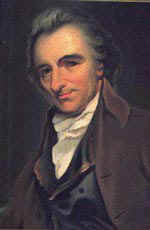PAINE’S FOOTNOTE ON THE TRANSIT OF VENUS
Robert J. Havlik, Emeritus Librarian
University of Notre Dame

____________________________________________________________
Paine, Thomas, The Age of Reason, Being an Investigation of True and
Fabulous Theology, Paris, 1794. In, The Age of Reason by Thomas
Paine, with a biographical introduction by Philip S. Foner, Secaucus, N.J.,
Carol Publishing Group; 1997; pp. 86 - 88.
The Sun is the center, round which those six worlds or planets revolve at different distances there from, and in circles concentric to each other. Each world keeps constantly in nearly the same track round the Sun, and continues, at the same time, turning round itself in nearly an upright position, as a top turns round itself when it is spinning on the ground and leans a little sideways.
Every time that a planet (our earth for example) turns round itself, it makes
what we call day and night; and every time it goes entirely round the Sun it
makes what we call a year; consequently our world turns three hundred and
sixty-five times round itself in going once round the Sun.0
The names that the ancients gave to those six worlds, and which are still called by the same names, are Mercury, Venus, this world that we call ours, Mars, Jupiter and Saturn. The appear larger to the eye than the stars, being many million miles nearer to our earth than any of the stars are. The planet Venus is that which is called the evening star, an sometimes the morning star, as she happens to set after or rise before the Sun, which in either case is never more than three hours.
This Sun, as before said, being the center, the planet or world nearest the Sun is Mercury; his distance from the Sun is thirty-four million miles, and he moves round in a circle always at that distance from the Sun, as a top may be supposed to spin round in the track in which a horse goes in a mill.
The second world is Venus; she is fifty-seven million miles distant from the Sun, and consequently moves round in a circle much greater than that of Mercury. The third world is this that we inhabit, and which is eighty-eight million miles distant from the Sun, and consequently moves round in a circle greater than that of Venus.
The fourth world is Mars; he is distant from the Sun one hundred and thirty-four million miles, and consequently moves round in a circle greater than that of our earth. The fifth is Jupiter; he is distant from the Sun five hundred and fifty-seven million miles, and consequently moves round in a circle greater than Mars.
The sixth world is Saturn; he is distant from the Sun seven hundred and sixty-three million miles, and consequently moves round in a circle that surrounds the circles, or orbits, of all the other worlds or planets.
The space, therefore, in the air, or in the immensity of space, that our
solar system takes up for the several worlds to perform their revolutions in
round the Sun, is of the extent in a straight line of the whole diameter of the
orbit, or circle, in which Saturn moves round the Sun, which being double his
distance from the Sun, is fifteen hundred and twenty-six million miles and its
circular extent is nearly five thousand million, and its globular contents are
almost three thousand five hundred million times three thousand five hundred
million square miles.0
11. It should be asked, how can man know these things? I have one plain answer to give, which is, that man knows how to calculate an eclipse, and also how to calculate to a minute of time when the planet Venus in making her revolutions around the sun will come in a straight line between our earth and the sun, and will appear to us about the size of a large pea passing across the face of the sun. This happens but twice in about a hundred years, at the distance of about eight years fro each other, and has happened twice in our time, both of which were foreknown by calculation. It can also be known when they will happen again for a thousand years to come, or to any other portion of time. As, therefore, man could not be able to do these things if he did not understand the solar system, and the manner in which the revolutions of the several planets or worlds are performed, the fact of calculating an eclipse, or a transit of Venus, is a proof in point that the knowledge exists; and as to a few thousand, or even a few million miles, more or less, it makes scarcely any sensible difference in such immense distances. - Author.